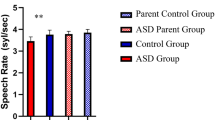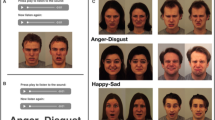Speakers with autism spectrum disorders (ASD) show difficulties in suprasegmental aspects of speech production, or prosody, those aspects of speech that accompany words and sentences and create what is commonly called “tone of voice.” However, little is known about the perception of prosody, or about the specific aspects of prosodic production that result in the perception of “oddness.” The present study examined the perception and production of a range of specific prosodic elements in an experimental protocol involving natural speech among speakers with ASD between 14 and 21 years of age, in comparison with a typical control group. Results revealed ceiling effects limiting interpretation of findings for some aspects of prosody. However, there were significant between-group differences in aspects of stress perception and production. The implications of these findings for understanding prosodic deficits is speakers with autism spectrum disorders, and for future research in this area, are discussed.
Similar content being viewed by others
References
InstitutionalAuthorNameAmerican Psychiatric Association (1994) Diagnostic and statistical manual of mental disorders (4th ed) Author Washington, DC
C. Baltaxe (1984) ArticleTitleUse of contrastive stress in normal, aphasic, and autistic children Journal of Speech and Hearing Research 24 97–105
C. Baltaxe D. Guthrie (1987) ArticleTitleThe use of primary sentence stress by normal, aphasic, and autistic children Journal of Autism and Developmental Disorders 17 255–271
C. Baltaxe J. Simmons (1985) Prosodic development in normal and autistic children E. Schopler G. Mesibov (Eds) Communication problems in autism Plenum Press New York 95–125
C. Baltaxe J. Simmons (1992) A comparison of language issues in high-functioning autism and related disorders with onset in children and adolescence E. Schopler G. Mesibov (Eds) High functioning individuals with autism Plenum Press New York 210–225
C. Baltaxe J. Simmons E. Zee (1984) Intonation patterns in normal, autistic and aphasic children A. Cohen M. Broecke Particlevan de (Eds) Proceedings of the Tenth International Congress of Phonetic Sciences Foris Publications Dordrecht, The Netherlands 713–718
E. Bates B. McWhinney (1979) A functionalist approach to the acquisition of grammar E. Ochs B. Schieffelin (Eds) Developmental pragmatics Academic Press New York 167–211
D. Bolinger (1989) Intonation and its uses: Melody in grammar and discourse Standford University Press Stanford, CA
J. Boucher V. Lewis G. Collis (1998) ArticleTitleFamiliar face and voice matching and recognition in children with autism Journal of Child Psychology and Psychiatry 39 171–182
A. Carter F. Volkmar S. Sparrow J. Wang C. Lord G. Dawson E. Fombonne K. Loveland G. Mesibov E. Schopler (1998) ArticleTitleThe Vineland Adaptive Behavior Scales: Supplementary norms for individuals with autism Journal of Autism and Developmental Disorders 28 287–302
D. Crystal (1986) Prosodic development P. Fletcher M. Garman (Eds) Language acquisition Cambridge University Press Cambridge, UK 33–48
M. DeMyer S. Barton W. DeMyer J. Norton J. Allen R. Stelle (1973) ArticleTitlePrognosis in autism: A follow-up study Journal of Autism and Childhood Schizophrenia 3 199–246
W. Fay (1969) ArticleTitleOn the basis of autistic echolalia Journal of Communication Disorders 2 38–47
W. Fay A. Schuler (1980) Emerging language in autistic children University Park Press Baltimore, MD
J. Fine G. Bartolucci G. Ginsberg P. Szatmari (1991) ArticleTitleThe use of intonation to communicate in pervasive developmental disorders Journal of Child Psychology and Psychiatry 32 771–782
Fosnot, S., & Jun, S. (1999). Prosodic characteristics in children with stuttering or autism during reading and imitation. Proceedings of the 14th International Congress of Phonetic Sciences. pp. 1925–1928.
L. Gerken (1996) ArticleTitleProsody’s role in language acquisition and adult parsing Journal of Psycholinguistic Research 25 345–356
L. Gerken K. McGregor (1998) ArticleTitleAn overview of prosody and its role in normal and disordered child language American Journal of Speech-Language Pathology 7 IssueID2 38–48
M. Ghaziuddin L. Gerstein (1996) ArticleTitlePedantic speaking style differentiates Asperger syndrome from high-functioning autism Journal of Autism and Developmental Disorders 26 585–595
P. Hargrove (1997) ArticleTitleProsodic aspects of language impairment in children Topics in Language Disorders 17 IssueID4 76–83
S. Haviland H. Clark (1974) ArticleTitleWhat’s new: Acquiring new information as a process in comprehension Journal of Verbal Learning and Verbal Behavior 8 166–169
R. Hobson J. Ouston A. Lee (1988) ArticleTitleEmotion recognition in autism: Coordinating faces and voices Psychological Medicine 18 911–923
R. Hobson J. Ouston A. Lee (1989) ArticleTitleNaming emotion in faces and voices: Abilities and disabilities in autism and mental retardation British Journal of Developmental Psychology 7 237–250
L. Kanner (1943) ArticleTitleAutistic disturbances of affective contact Nervous Child 2 217–250
L. Kanner (1971) ArticleTitleFollow-up of eleven autistic children, originally reported in 1943 Journal of Autism and Childhood Schizophrenia 2 119–145
R. Kent C. Read (1992) The acoustic analysis of speech Singular Publishing Group San Diego, CA
A. Klin J. Lang D. V. Cicchetti F. R. Volkmar (2000) ArticleTitleInterrater reliability of clinical diagnosis and DSM-IV criteria for autistic disorder: Results of the DSM-IV autism field trial Journal of Autism and Developmental Disorders 30 IssueID2 163–167
R. Landa (2000) Social language use in Asperger syndrome and high-functioning autism A. Klin F. Volkmar S. Sparrow (Eds) Asperger syndrome Guilford Press New York 125–158
M. Liss B. Harel D. Fein D. Allen M. Dunn C. Feinstein R. Morris L. Waterhouse I. Rapin (2001) ArticleTitlePredictors and correlates of adaptive functioning in children with developmental disorders Journal of Autism and Developmental Disorders 31 219–230
C. Lord M. Rutter A. LeCouteur (1994) ArticleTitleAutism Diagnostic Interview-Revised: A revised version of a diagnostic interview for caregivers of individuals with possible pervasive developmental disorders Journal of Autism and Developmental Disorders 24 IssueID5 659–685
C. Lord S. Risi L. Lambrecht E. H. Cook SuffixJr. B. L. Leventhal P. C. DiLavore A. Pickles M. Rutter (2000) ArticleTitleThe Autism Diagnostic Observation Schedule - Generic: A standard measure of social and communication deficits associated with the spectrum of autism Journal of Autism and Developmental Disorders 30 IssueID3 205–223
K. Loveland M. Kelley (1991) ArticleTitleDevelopment of adaptive behavior in preschoolers with autism or Down syndrome American Journal of Mental Retardation 96 3–20
P. McCaleb B. Prizant (1985) ArticleTitleEncoding of new versus old information by autistic children Journal of Speech and Hearing Disorders 50 30–240
J. McCann S. Peppe (2003) ArticleTitleProsody in autism spectrum disorders: A critical review International Journal of Language and Communication Disorders 38 25–350
R. Merewether M. Alpert (1990) ArticleTitleThe components and neuroanatomic bases of prosody Journal of Communication Disorders 23 325–336
G. Mesibov (1992) Treatment issues with high-functioning adolescents and adults with autism E. Schopler G. Mesibov (Eds) High functioning individuals with autism Plenum Press New York 143–156
E. Ornitz E. Ritvo (1976) Medical assessment E. Ritvo (Eds) Autism: Diagnosis, current research, and management Spectrum Publications New York 7–26
J. Paccia F. Curcio (1982) ArticleTitleLanguage processing and forms of immediate echolalia in autistic children Journal of Speech and Hearing Research 25 42–47
J. Panagos P. Prelock (1997) ArticleTitleProsodic analysis of child speech Topics in Language Disorders 17 IssueID4 1–10
A. Patel I. Peretz M. Tramo R. Lebreque (1998) ArticleTitleProcessing prosodic and musical patterns: A neurophychological investigation Brain and Language 43 4–11
R. Paul (1987) Communication D. Cohen A. Donnellan (Eds) Handbook of autism and pervasive developmental disorders Wiley New York 61–84
Paul, R., Shriberg, L., McSweeney, J., Cicchetti, D., Klin, A., & Volkmar, R. (2004). Relations between prosodic performance and communication and socialization ratings in high functioning speakers with autism spectrum disorders. Journal of Autism and Developmental Disorders, (in press).
W. Pronovost M. Wakstein D. Wakstein (1966) ArticleTitleA longitudinal study of speech behavior and language comprehension in fourteen children diagnosed as atypical or autistic Exceptional Children 33 19–26
R. Quirk S. Greenbaum G. Leech J. Svartivik (1990) A Comprehensive Grammar of the English Language Longman N.Y.
J. Rodrigue S. Morgan G. Gefken (1991) ArticleTitleA comparisative evaluation of adaptaive behavior in children and adolescents with autism Down syndrome and normal development Journal of Autism and Developmental Disorders 21 187–198
D. Ricks (1975) Vocal communication in pre-verbal normal and autistic children N. O’Connor (Eds) Language, cognitive deficits, and retardation Butterworths London 245–268
J. Schatz G. Hamdan-Allen (1995) ArticleTitleEffects of age and IQ on adaptive behavior domains for children with autism Journal of Autism and Developmental Disorders 25 51–60
L. D. Shriberg C. J. Widder (1990) ArticleTitleSpeech and prosody characteristics of adults with mental retardation Journal of Speech and Hearing Research 33 627–653
L. D. Shriberg J. Kwiatkowski C. Rasmussen (1990) The prosody-voice screening profile Communication Skill Builders Tucson, AZ
L. Shriberg R. Paul J. McSweeney A. Klin D. Cohen F. Volkmar (2001) ArticleTitleSpeech and prosody characteristics of adolescents and adults with high functioning autism and Asperger syndrome Journal of Speech, Language and Hearing Research 44 1097–1115
J. Simmons C. Baltaxe (1975) ArticleTitleLanguage patterns in adolescent autistics Journal of Autism and Childhood Schizophrenia 5 333–351
S. Sparrow D. Balla D. Cicchetti (1984) Vineland Adaptive Behavior Scales American Guidance Service Circle Pines, MN
H. Tager-Flusberg (1981) ArticleTitleOn the nature of linguistic functioning in early infantile autism Journal of Autism and Developmental Disorders 11 45–56
H. Tager-Flusberg (1995) Dissociation in form and function in the acquisition of language by autistic children H. Tager-Flusberg (Eds) Constraints on language acquisition: Studies of atypical children Erlbaum Hillsdale, NJ 175–194
C. Thurber H. Tager-Flusberg (1993) ArticleTitlePauses in the narrative produced by autistic, mentally retarded, and normal children as an index of cognitive demand Journal of Autism and Developmental Disorders 23 309–322
M. VanBourgondien A. Woods (1992) Vocational possibilities for high functioning adults with autism E. Schopler G. Mesibov (Eds) High functioning individuals with autism Plenum Press New York 227–242
D. Van Lancker G. Canter D. Terbeek (1981) ArticleTitleDisambiguation of ditropic sentences: Acoustic and phonetic cues Journal of Speech and Hearing Research 24 330–335
D. Van Lancker C. Cornelius J. Krieman (1989) ArticleTitleRecognition of emotional-prosodic meanings in speech by autistic, schizophrenic, and normal children Developmental Neuropsychology 5 207–222
Warren, P. (Ed.) (1996). Parsing and prosody: An introduction. Prosody and parsing. (pp. 1–16). East Sussex, UK: Psychology Press.
D. Wechsler (1992) Wechsler intelligence scale for children EditionNumber3 Psychological Corp San Antonio, TX
D. Wechsler (1997) Wechsler adult intelligence scale EditionNumber3 Psychological Corp San Antonio, TX
E. Wiig W. Secord (1989) Test of language competence Psychological Corp San Antonio, TX
E. Winner (1988) The point of words: Children’s understanding of metaphor and irony Harvard University Press Cambridge, MA
Author information
Authors and Affiliations
Corresponding author
Rights and permissions
About this article
Cite this article
Paul, R., Augustyn, A., Klin, A. et al. Perception and Production of Prosody by Speakers with Autism Spectrum Disorders. J Autism Dev Disord 35, 205–220 (2005). https://doi.org/10.1007/s10803-004-1999-1
Issue Date:
DOI: https://doi.org/10.1007/s10803-004-1999-1




